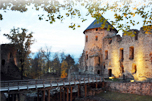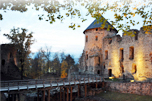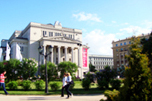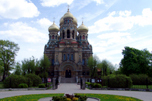Apart from their common belief in Buddhism, Tibetan monks and nuns, as a social group, were a community full of contradictions, with huge gaps in wealth and social status.
Monasteries: The Epitome of the Old Tibetan Society
The old Tibetan code clearly stipulates: "People are divided into three categories--upper, middle and lower. In each category, there are three grades--upper, middle and lower." Laws stipulated that special Living Buddhas such as the Dalai and Panchen lamas belonged to the supreme upper class; the Kampus abbot and Living Buddha of big monasteries belonged to the middle-level upper class; the Zhacang (Buddhist college) abbots of big monasteries, Living Buddhas and Geshi degree bhiksu in the lower level of the upper class; the deacons (karmadana) and elder monks representing the upper-middle class, and ordinary monks in the mid-level and new monks in the 1ower-middle class.
On the one hand, the social status of monks was generally above that of the laity, while, on the other hand, there remained different classes in monkhood. Nuns were in a lower position than their male counterparts. Both monks and nuns were deprived of equal rights before the law.
According to a survey conducted in l958 in Lhasa's Sera Monastery, the monks there were usually divided into many classes such as Living Buddhas (Coqen Hall and Zhacang), Kampus, Gyisoi, Coqen Xie'e and Sengkam Deba, Coqen Hall Ongze, Coqen Gegui, Coqen Gornyi, and Gyiacui Deba, Nyican and Lhadrung Qamzo, Damxung Gyiqiao, Zhacang Kangnyi, Zhacang Qamzo, Zhacang Gegui, Zhacang Qiaorab and Kamcun chiefs in position. Upper class religious persons were appointed to Zhacang Kangnyi or positions above by the Gaxag government, controlling its economic and religious rights, enjoying various feudal privileges, and becoming religious feudal lords. Common monks were forced into rotating positions for which they had to pay at least l00 yuan each, commonly considered as a corvee burden.
To avoid this burden, the only way out for ordinary monks was to buy a Qunze. These were either Zhacang Qunze or Kamcun Qunze, according to the amount paid. Once the Qunze was bought, a monk could avoid the rotational duty of Kamcun headman, as well as the manual labor that young monks were normally required to do. He could also occupy a better position during the gatherings of monks. A few Qunzes could even climb to high religious positions, depending on the political and economic background of their fami1ies. But most spent their lives achieving nothing.
Take a medium-level Qunze in Sera Monastery for example: in Gyizhacang, the payment was about l,000 silver dollars, and in Maizhacang, it was l,235 silver dollars. This was beyond the means of an ordinary monk from a poor family of herdsman or serf.
Monk Students and Ordinary Lamas
Under the feudal serf system, common monks and nuns were sent to temples at the age of seven or eight, in addition to reincarnated Living Buddhas and monks with noble family background. Some parents did this out of religious belief, while others wanted to seek a way out for their children due to financial shortage, or they were forced into it by monasteries.
In monasteries, monk students usually held higher positions than ordinary monks. When they entered the fourth grade, the monks did not need to perform manual labor any more. It was commonly said that they had to work hard for 20--30 years in going through the Open School and then to the Tantric school. A few monks could reach the highest abbot position of the Yellow Sect--Gandain Chiba abbot. As the proverb went: "Gandain Chiba abbot is there, it all depends on your ability". On the surface, there was a chance of fair competition, but actually, the monk students only accounted for one fifth of the total number. Only a few could gain the position, and not all through hard work.
According to the l958 survey of the Sera Monastery, among the 2,000 Hangdong Kamcuns, there were only 400 monk students (Bechawa), accounting for one-fifth of the total; of the l70 Ngari Kamcuns, 30 were monk students, making up a proportion of one-sixth; of the l,000 T8ntric monks in Ngaba Zhacang, 200 were n1onk students, which was only one--fifth in proportion.
The first reason was related to living conditions. The three famous monasteries in Lhasa, for example, owned numerous manors, pasture land and serfs, amounting to 70 percent of the social wealth. Besides, they had special rights of enforcing usury.
In August l959, Zhaibung Monastery stored in its warehouses 48,424 ke (abou4678,000 kg) of grain, l4,272 ke (85, 632 kg) of butter, nearly l00 kg of gold (excluding the go1d sacrificial vessels), 4,700 kg of silver and 2l2,388 silver coins. This huge wea1th was most]y wasted by the religious feudal lords. The yearly income of an ordinary monk would be 20 kg of zanha (roasted highland qingke barley flour), 78 kg of qingke, 5 kg of butter and two silver coins, p1us the income from the Grand Summons Ceremony which included 26 silver coins, 6 kg of zanba and four pieces of fried food. This cou1d only support him for half a year, so, for the other half, he had to go out to look for a job. This made it difficult for monks from poor families to become monk students.
The second reason was the consideration of prospects. A monk student wou1d be promoted only when he had obtained the Geshi degree. However, this called for at least 20 years' hard study of Buddhism, and impressive economic strength. Usually, a monk student could afford the grade promotion during the period of study, but not the huge fee needed for a Geshi degree examination. In the Sera Monastery, for example, a monk student, who had passed the ordinary Geshi degree examination, needed to pay l,700 yuan for medium--level alms and sacrificial food and tea. One who passed the Gra11d Summons Ceremony examination, and had thus won the Charanba Geshi, would have to pay over 2,000 yuan for the purpose. There were also the gifts sent to religious persons in authority. It was said that when Dazha ruled as the Prince Regent, a monk student had to present gifts valued at 7,000-l0,000 yuan for the registration. So, most monk students failed to get a degree after a whole life's hard work.
Poor Monks and Nuns Take Up 70 Percent of the Total Community
Under the temporal and religious administration in Tibet, the status of monks and nuns in monasteries reflected their family background. Monks from noble families would soon take power and join the upper religious circle after they entered the monasteries. They could use feudal privilege to exploit the poor monks in the monasteries and the poor people outside, living an extravagant and dissipated life. Those from ordinary families entered monasteries out of a belief in Buddhism or cherishing the wish to escape from poverty, but what most of them confronted in return was not "benevo1ence, love and equality", but rather being oppressed and exploited. According to a l959 survey, among the l 20,000 monks and nuns in monasteries, 70 percent were poor.
Poor lamas had to bear the following corvee: l) l2- l5 years of corvee in monasteries, including transporting goods and repairing houses. 2) Acting as Kamcun chief by turn. Taking the rich Hangdong Kamcun in l958 in the Sera Monastery for example. A "Nyingtu" had to pay over l00 silver dollars in three years; a "Lama Qoiba" nearly 1,000 silver dollars in three years; a "Nyiba" nearly 2,000 silver dollars in two years; and a "Gedain" over 2,600 silver dollars in two years. 3) Many poor Kamcun chiefs forced other monks to sign contracts to borrow money from them at a high interest rate. According to the contract, lamas could only pay the interest, but never the capital, which meant life-long exploitation.
Life of Ordinary Monks and Nuns
Monks and nuns belonged to different classes in the monasteries, which determined the huge gap between them. In addition, there were other elements that had impact on their life, as shown in this example from the Sera Monastery before the Democratic Reform in l959:
Monk Norsang, who was a Ngaba Zhacang, enjoyed a life of upper--medium level. In addition to his remuneration above other Zhacangs of the Open School, and his family aid, he did sewing work, which earned additional income. His annual expenditure totaled 24l .5 silver dollars. He neither owed others debt nor had any extra money.
The middle -aged monk student Yexei Goinsang belonged to medium level Boniao Kamcun. His family had at one time aided him. His annual expenses totaled about l67.25 silver dollars. Kamcun monks like him took up half the total number.
The old monk student Damqoi Yexi belonged to the lower level Gora Kamcun. He had no-one left in the family, and he was too old to support himself. So, he could hardly have a full meal all the year round. He spent about 113 silver dollars a year, and owed others 100 silver dollars. Such monks accounted for 25 percent of the total Zhacang monks.
Old Xerab Wangqug of Geshi degree led the life of a lower Nyiba Kamcun. He had no family aid, and he was too old to support himself. He had borrowed money for the Geshi examination 30 years before, and had been in debt ever since. He could not possibly return the money, and still owed 200 silver dollars. He couldn't afford butter, but had to re1y on zanba supplied by the monastery, and was ot1e11 hungry. His annual spending was 96 silver dollars.
In the Sera Monastery, 24 percent of the monks were old, weak and suffered from illness. They had to beg for food on Lhasa streets for five to six months each year. In comparison, Phala Yexei Qoinpei, the upper chief of the Zhaibung Monastery, had an annual income of 33,000 silver dollars.
Religious Feudal Privilege
The upper-class monks occupied a large amount of the social wealth and means of production, and enjoyed many political privileges. These religious feudal lords could not be held accountable for killing any of the poor monks and nuns, serfs and slaves they owned. They could directly send off icia1s to monastery--owned manors and pasture land to manage local administrative affairs. They could also assign Kambo and Qumzuo to the branch monasteries to manage their religious at1hirs. Upper-class monks and nuns had complete handling rights of the monastery's internal affairs and could dea1 with everything within the monastery without local government interference. Some big monasteries even had their own armed forces, courts, punishment tools and prison. They treated their monks and nuns and serfs even worse than the judicial system of the former Tibetan government.
For example, Norsang Chilie, one of the ordinary lamas of the Sera Monastery, was disabled for life after being beaten l00 times with a rod for not being timely in saluting the bailiff of a Living Buddha he encountered on the way.
Gyisoi, nicknamed "tiger mouth" in the Zhaibung Monastery, often went to exploit and oppress the serfs in his manor's pastoral areas. In l958, when he visited another monastery he owned, he raped nuns there and all women in the nearby village with 60 households. Qamba Tubdain, a 73--year-old villager, took him to task over this, but he cruelly beat the old man to death, while a 70-year--old uncle was disabled by a similar beating. Qamba Tubdain's mother, who cooked and served him, was beaten half to death and was bedridden for several months.
From 1958 to the beginning of l959, one Buddhist hall in the western suburbs of Lhasa collected from a chief lord 27 human heads, seven skulls, four calf bones, one whole human skin, one entire corpse, and l4 bundles of human intestines.







